Researching conflict
Understanding Colombia’s war
 Demotix/picture-alliance
Demotix/picture-alliance
In February, the Historical Commission on the Conflict and its Victims (Comisión Histórica del Conflicto Armado y sus Víctimas – CHCV) published its report. Entitled “Contribution to an Understanding of the Armed Conflict in Colombia”, the document consists of twelve individual reports and two introductions. The contributions deal with the “multiple reasons for the conflict, the principle factors and circumstances that made it possible and the most notable impacts on the population”.
The Historical Commission’s document supplements various prior reports that attempted to explain the outbreaks of violence. One of particular note was ¡Basta Ya! (That’s enough!) published by the National Centre for Historical Memory (CMH), a governmental institution.
The findings published by the CHCV help to understand Colombia’s armed conflict in terms of international law. The commission does not deliver a new explanatory model, but it indicates issues that must be investigated by a future truth commission. Such a commission must be set up according to Article 66 of Colombia’s constitution, and in the ongoing peace talks, the government and the FARC (Fuerzas Armados Revolucionarios de Colombia – Colombian armed revolutionary forces) rebels have agreed to do so.
The CHCV report analyses the causes and effects of guerrilla crimes. It offers proposals on how to investigate these crimes for judicial purposes, as must be done, according to Colombia’s Legal Framework For Peace (Marco Jurídico para la Paz – MJP), which was formally established by legislators in 2012.
Contribution to peace negotiations
The CHCV is not a truth commission but it paves the way for one. It focuses on the socio-political analysis of the Colombian conflict, methodically compiling opinions that experts expressed at round tables and similar events in the peace process. Relevant questions include: When did the conflict begin? What were the causes and consequences? And why does it persist?
Colombia’s government has been holding peace talks with the FARC rebels in Havana since the end of 2012. Basically, the present report – with its focus on the victims – is a contribution to those negotiations. It is a collection of different views, not a coherent result of teamwork like the report presented by Brazil’s Truth Commission last year (see Kai Ambos and Eneas Romero E+Z/D+C 2015/03, p. 36 ff.). That was the work of an interdisciplinary research group with an explicit mandate to investigate the human-rights violations committed during Brazil’s military dictatorship and to name those who were responsible.
Versions of the conflict
Colombia has a law relating to victims of conflict and to the handing back of land (Law 1448 of 2011), so the judicial scrutiny of the conflict has already begun. The present collection of reports offers an analysis of the violence perpetrated against civilians. Based on earlier reports by the National Centre for Historical Memory, the CHCV contributions elaborate how armed groups made Colombia’s civilian population victims of displacement, expropriation, abduction, extortion, recruitment of minors, torture, murder, massacre, rape, kidnap, anti-personnel mines, robbery and terror attacks.
Despite using different terminology (armed social conflict, civil war, irregular conflict, war), the separate reports agree on the essential characteristics of the conflict – the duration, complexity, interruptions, regional differences and brutality. And all of the reports rely on the norms of international criminal law.
In the discussion about the actors in the conflict, it is interesting to note that different authors characterise the various new criminal groups that are known as the BACRIM (bandas criminales – criminal gangs) in Colombia. Some of them have emerged from paramilitary counter-insurgency organisations. Víctor Moncayo emphasises the continuity of the conflict which now involves new paramilitary gangs. Javier Giraldo sees the BACRIM linked to the war strategies of the government and big business. Daniel Pecaut blames the escalation of conflict on the BACRIM. He considers them responsible for ongoing displacements and the murder of political and social leaders. Pecaut also speaks of institutional support resulting in systematic acts of crime.
Vicente Torrijos sees the BACRIM as heirs of the private counter-insurgency forces. He distinguishes two types of BACRIM. One has emerged from paramilitary gangs, and the other is a FARC-BACRIM hybrid which he calls FARCRIM. In his eyes, the FARCRIM are a continuation of FARC with formal, permanent alliances. Torrijos demonstrates that the FARCRIM operate according to strategic plans. These criminal groups are thus armed forces with a command structure inherited from paramilitary units. They have the capacity to plan violent acts and carry them out with organisational discipline and de facto, though not legal authority. These new groups are certainly capable of committing crimes against humanity and have become parties in the armed conflict in Colombia.
Impacts on transitional justice
With regard to guerrilla crime, many observers point out that the guerrilleros are driven by altruistic motives. They similarly emphasise the relevance of drug trafficking. In any analysis of guerrilla crime, a distinction must be made between the socio-political dimensions and those dimensions that relate to penal law. The CHCV report contains objective and subjective criteria that should be relevant for the criminal investigations.
The CHCV not only makes an important contribution to the clarification of Colombia’s complex armed conflict; it also reveals the limits of criminal law, which can only play a supporting role in peace building, but cannot achieve peace in and of itself. In other words, solutions to the conflict are more likely to be found in the political than the legal arena.
It is impossible to clarify the reasons for the ongoing violence in Colombia completely because the various authors’ views diverge too much. However, the contributions in the CHCV publication identify beyond doubt the factors that have caused the violence to persist for so long. The publication also shows that the civilian population is affected and highlights the cruelty of the conflict. It names those responsible and provides guidance on post-conflict management and transitional justice.
Kai Ambos is a professor of criminal law, criminal procedure, comparative law and international criminal law at Göttingen University and director of the Centro de Estudios de Derecho Penal y Procesal Penal Latinoamericano (CEDPAL); he is also a judge at Göttingen Regional Court (currently delegated to Braunschweig Higher Regional Court).
kambos@gwdg.de
John Zuluaga is a doctoral student and researcher at CEDPAL.
j.zuluagataborda@stud.uni-goettingen.de
Links:
Comisión Histórica del Conflicto Armado y sus Víctimas (in Spanish):
http://justiciaypazcolombia.com/Informe-Comision-Historica-del
Centro Nacional de Memoria Histórica (in Spanish):
http://www.centrodememoriahistorica.gov.co/
Unidad para la Atención y Reparación Integral a las Víctimas (in Spanish):
http://www.unidadvictimas.gov.co/index.php/en/
